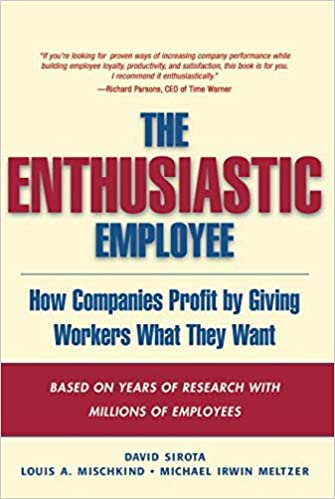The Enthusiastic Employee – David Sirota, Louis A. Mischkind and Michael Irwin Meltzer

The central argument of “The Enthusiastic Employee: How Companies Profit by Giving Workers What They Want” is that companies can increase their profits by creating a work environment that fosters employee enthusiasm and engagement. The authors provide evidence from surveys and case studies to show that employees who feel valued and supported by their organizations are more productive, more creative, and more likely to stay with the company.
Enthusiasm Matters
Enthusiasm is a key driver of productivity, creativity, and commitment in the workplace. Employees who are enthusiastic about their work and their company are more likely to be successful and to help their organization succeed.
Work-Life Balance
Employees want to balance their work and personal lives. Companies should offer flexible schedules, telecommuting options, and other benefits that support work-life balance.
Communication
Open and transparent communication is essential for building trust and engagement. Companies should communicate regularly and honestly with employees, and provide opportunities for feedback and discussion.
The Bottom Line
Investing in employee enthusiasm and engagement can have a significant impact on the bottom line. Companies that create a positive work environment and prioritize employee well-being are more likely to attract and retain talented employees, and to be successful over the long term.
Leadership Matters
Leadership is a critical factor in creating an enthusiastic and engaged workforce. Leaders should set clear goals, provide support and resources, and communicate regularly with employees.
The Importance of Employee Feedback
Regular feedback from employees is crucial for understanding their needs, motivations, and concerns. Companies should create formal and informal channels for feedback, and use it to improve policies, procedures, and communication.
Training and Development
Investing in employee training and development can increase job satisfaction and improve performance. Companies should provide opportunities for employees to learn new skills and take on new challenges.
Culture and Values
A strong organizational culture and clear values can help employees feel connected to their work and their company. Companies should articulate their values and work to create a culture that aligns with them.
Fairness and Respect
Employees want to feel that they are treated fairly and with respect. Companies should strive to create a culture of fairness and respect by providing clear policies, consistent treatment, and open communication.
Recognition and Rewards
Recognition and rewards are powerful motivators for employees. Companies should develop meaningful and appropriate ways to recognize and reward employees for their achievements, such as promotions, bonuses, and public recognition.



Comments ()